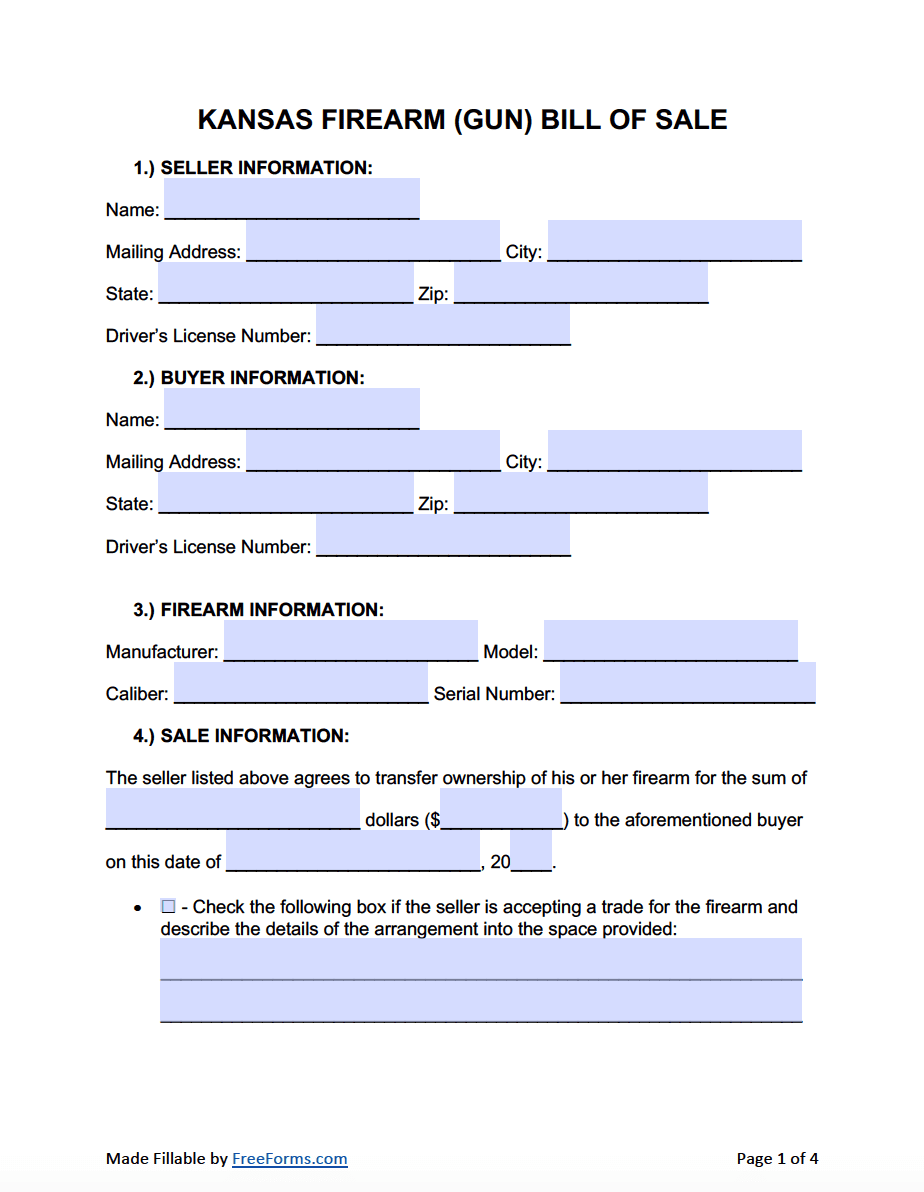The Kansas firearm (gun) bill of sale form is essential to anyone selling, buying, or trading a firearm. It is important to create a record of the transaction for legal purposes, as it may be of use in the future if you ever have to prove that you own or no longer own the property. Distinct material facts are logged into the form specifying how the transaction was executed. Once all the information has been logged into the document, participating parties will then provide their signatures under the review of a notary public, who may then certify the agreement upon approval. The seller must make sure the buyer is of legal age before selling the gun.
How to Register a Gun
There is no decree within Kansas’s written law that states that a citizen who acquires a gun must register it with the state. Kansas is one of the least restrictive states when it comes to firearm regulations and does not impose any type of special licensing or permits, even for concealed carry. That being said, it is still an option to attain a CCHL (Concealed Carry Handgun License) if a person would like the added benefit of reciprocity, which is when other mutual states recognize the license.
How to Obtain a Concealed Carry Permit
The state of Kansas requires individuals looking to receive a CCHL to apply through their county’s local sheriff’s department. It is requested that you deliver the paperwork in-person so that you can execute some additional formalities. Must accomplish the following:
- Fulfill the obligation of completing the Kansas Concealed Carry Application (provided by the state).
- Submit to a fingerprint scan and background check regarding your criminal history.
- Provide evidence that the applicant has completed a firearms instruction course that meets the necessary standards (either a certificate or affidavit signed by an authorized instructor). The average cost of a handgun safety course is $100.00, prices vary depending on which class you attend.
- Make a copy of your government-issued driver’s license or state ID to include in your filing (individuals who were not born in the United States should make copies of any documentation demonstrating legal residency).
- Supply a passport-style photo that can be attached to the application form (most photography supply stores will provide this service). The photo must be:
- Taken within 30 days of applying.
- Color
- 2 x 2 inches
- A full view of the applicant’s face from the shoulders to the top of the head (do not wear any items that may obstruct your face or profile i.e. sunglasses or hat).
- Appease any costs associated with the application process. Acceptable methods of payment are; personal checks, cashier’s checks, or money orders. The fees will include:
- $32.50 (made payable to your local sheriff’s department)
- $79.50 (made out to the “Office of the Attorney General”)
- $16.00 (the fee charged by the Kansas Department of Revenue to actually issue the physical license)
- All fees are non-refundable.
The state is legally allowed 9o days to process your application (although, you will most likely be notified within 1-2 months). If your request was approved, you will receive a letter via mail directing you to retrieve your CCHL at a location that issues driver’s licenses. CCHL’s have an expiration date of 4 years. (For further details on the laws regarding CCHL applications, review K.S.A. 75-7c04.)
How to Write
Step 1 – Download in Adobe PDF.
Step 2 – Both Parties’ Information – The seller and buyer must produce the information requested within the first 2 sections of the form:
- Name
- Mailing Address
- City
- State
- Zip
- Driver’s License Number
Step 3 – Specifying the Gun – It is important that the firearm being transferred is accurately described. Insert the information that corresponds with the following inquiries:
- Manufacturer
- Model
- Caliber
- Serial Number
Step 4 – Transaction Specifics – Input the information that has been prearranged by the transferor and transferee regarding the sale/purchase or trade:
- Enter the purchase price in long-form.
- Enter the purchase price numerically.
- Date of Exchange (month, day, year)
- If the transaction involves a trade, provide a checkmark on the indicated box and stipulate the terms and conditions within the available space.
Step 5 – Disclosures – It is necessary that both individuals taking part in the transfer review the disclosure section appointed to them. If they agree that the statements expressed within the section are factual, they must then provide a signature on the given line.
Step 6 – Closing Actions – The final step entails all parties involved to finalize the document by supplying:
- The Buyer’s Signature and Printed Name
- The Seller’s Signature and Printed Name
- 2 Witness Signatures and Printed Names
Achieve this while under the review of a notary public, who may then authenticate the contract for legal purposes.
